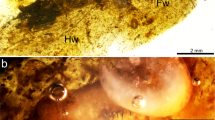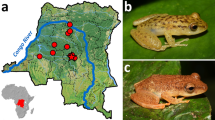Abstract
Fleas are one of the major lineages of ectoparasitic insects and are now highly specialized for feeding on the blood of birds or mammals1. This has isolated them among holometabolan insect orders, although they derive from the Antliophora (scorpionflies and true flies). Like most ectoparasitic lineages, their fossil record is meagre and confined to Cenozoic-era representatives of modern families1, so that we lack evidence of the origins of fleas in the Mesozoic era. The origins of the first recognized Cretaceous stem-group flea, Tarwinia, remains highly controversial1. Here we report fossils of the oldest definitive fleas—giant forms from the Middle Jurassic and Early Cretaceous periods of China. They exhibit many defining features of fleas but retain primitive traits such as non-jumping hindlegs. More importantly, all have stout and elongate sucking siphons for piercing the hides of their hosts, implying that these fleas may be rooted among the pollinating ‘long siphonate’ scorpionflies of the Mesozoic. Their special morphology suggests that their earliest hosts were hairy or feathered ‘reptilians’, and that they radiated to mammalian and bird hosts later in the Cenozoic.
This is a preview of subscription content, access via your institution
Access options
Subscribe to this journal
Receive 51 print issues and online access
$199.00 per year
only $3.90 per issue
Buy this article
- Purchase on Springer Link
- Instant access to full article PDF
Prices may be subject to local taxes which are calculated during checkout




Similar content being viewed by others
References
Grimaldi, D. & Engel, M. S. Evolution of the Insects (Cambridge Univ. Press, 2005)
Riek, E. F. Lower Cretaceous fleas. Nature 227, 746–747 (1970)
Jell, P. A. & Duncan, P. M. Invertebrates, mainly insects, from the freshwater Lower Cretaceous, Koonwarra Fossil Bed (Korumburra Group), South Gippsland, Victoria. Mem. Assoc. Australas. Palaeontol 3, 111–205 (1986)
Penny, N. D. A systematic study of the family Boreidae (Mecoptera). Univ. Kansas Sci. Bull. 51, 141–217 (1977)
Snodgrass, R. E. The skeletal anatomy of fleas (Siphonaptera). Smith. Misc. Coll. 104, 1–89 (1946)
Cheetham, T. B. Male Genitalia and Phylogeny of Pulicoidea (Koeltz Sci. Press, 1988)
Kluge, N. J. The homology of mouthparts in fleas (Insecta, Aphaniptera). Entomol. Rev. [transl.]. 82, 1020–1026 (2002)
Ren, D. et al. A probable pollination mode before angiosperms: Eurasian, longproboscid scorpionflies. Science 326, 840–847 (2009)
Whiting, M. F., Carpenter, J. M., Wheeler, Q. D. & Wheeler, W. C. The Strepsiptera problem: phylogeny of the holometabolous insect orders inferred from 18S and 28S ribosomal sequences and morphology. Syst. Biol. 46, 1–68 (1997)
Whiting, M. F. Mecoptera is paraphyletic: multiple genes and phylogeny of Mecoptera and Siphonaptera. Zool. Scr. 31, 93–104 (2002)
Friedrich, F. & Beutel, R. G. The thoracic morphology of Nannochorista (Nannochoristidae) and its implications for the phylogeny of Mecoptera and Antliophora. J. Zool. Syst. Evol. Res. 48, 50–74 (2010)
Beutel, R. G., Friedrich, F. & Whiting, M. F. Head morphology of Caurinus (Boreidae, Mecoptera) and its phylogenetic implications. Arthropod Struct. Dev. 37, 418–433 (2008)
Schneeberg, K. & Beutel, R. G. The adult head structures of Tipulomorpha (Diptera, Insecta) and their phylogenetic implications. Acta Zool. 92, 316–343 (2011)
Beutel, R. G. & Baum, E. Longstanding entomological problem finally solved? Head morphology of Nannochorista (Mecoptera, Insecta) and possible phylogenetic implications. J. Zoological Syst. Evol. Res. 46, 346–367 (2008)
Palmer, C. M. Diversity of feeding strategies in adult Mecoptera. Terrestr. Arthr. Rev. 3, 111–128 (2010)
Azar, D., Veltz, I. & Nel, A. Mandibulate chironomids: primitive or derived? (Diptera: Chironomidae). Syst. Entomol. 33, 688–699 (2008)
Whiting, M. F., Whiting, A. S., Hastriter, M. W. & Dittmar, K. A molecular phylogeny of fleas (Insecta: Siphonaptera): origins and host associations. Cladistics 24, 677–707 (2008)
Benton, M. J., Zhang, Z., Orr, P. J., Zhang, F. & Kearns, S. L. The remarkable fossils from the Early Cretaceous Jehol Biota of China and how they have changed our knowledge of Mesozoic life. Proc. Geol. Assoc. 119, 209–228 (2008)
Luo, Z.-X., Ji, Q. & Yuan, C. Convergent dental adaptations in pseudo-tribosphenic and tribosphenic mammals. Nature 450, 93–97 (2007)
Meng, J., Hu, Y., Wang, Y., Wang, X. & Li, C. A Mesozoic gliding mammal from northeastern China. Nature 444, 889–893 (2006)
Luo, Z.-X., Yuan, C., Meng, Q. & Ji, Q. A Jurassic eutherian mammal and divergence of marsupials and placentals. Nature 476, 442–445 (2011)
Zhang, F., Zhou, Z., Xu, X., Wang, X. & Sullivan, C. A bizarre Jurassic maniraptoran from China with elongate ribbon-like feathers. Nature 455, 1105–1108 (2008)
Ponomarenko, A. G. A new insect from the Cretaceous of Transbaikalia, a possible parasite of pterosaurians. Paleontol. J. 10, 339–343 (1976)
Acknowledgements
We are grateful to X. D. Wang for presenting specimen 154244, A. Short, X. Xu, F. C. Zhang, and X. L. Wang for discussions and S. Davis and X. Y. Fan for technical assistance. Financial support was provided by the National Natural Science Foundation of China, National Basic Research Program of China (2012CB821900), Chinese Academy of Sciences (KZCX2-YW-QN104) and the US National Science Foundation (DEB-0542909).
Author information
Authors and Affiliations
Contributions
All authors participated in morphological studies. D.H., M.S.E. and A.N. prepared the manuscript.
Corresponding authors
Ethics declarations
Competing interests
The authors declare no competing financial interests.
Supplementary information
Supplementary Information
This file contains Supplementary Text, Supplementary Table 1 and Supplementary Figures 1-4 with legends. (PDF 7455 kb)
Rights and permissions
About this article
Cite this article
Huang, D., Engel, M., Cai, C. et al. Diverse transitional giant fleas from the Mesozoic era of China. Nature 483, 201–204 (2012). https://doi.org/10.1038/nature10839
Received:
Accepted:
Published:
Issue Date:
DOI: https://doi.org/10.1038/nature10839
This article is cited by
-
Study on the Jehol Biota: Recent advances and future prospects
Science China Earth Sciences (2020)
-
New insects feeding on dinosaur feathers in mid-Cretaceous amber
Nature Communications (2019)
-
Ticks parasitised feathered dinosaurs as revealed by Cretaceous amber assemblages
Nature Communications (2017)
-
On the probability of dinosaur fleas
BMC Evolutionary Biology (2016)
-
The first flea with fully distended abdomen from the Early Cretaceous of China
BMC Evolutionary Biology (2014)
Comments
By submitting a comment you agree to abide by our Terms and Community Guidelines. If you find something abusive or that does not comply with our terms or guidelines please flag it as inappropriate.



